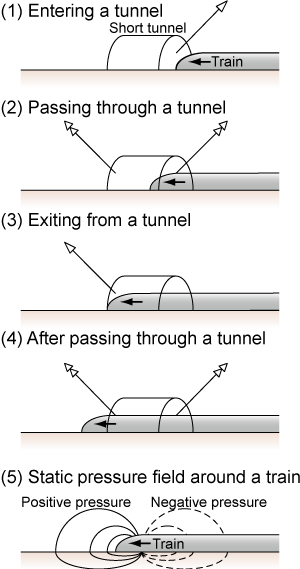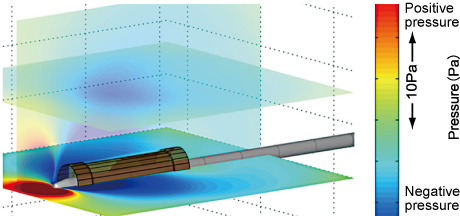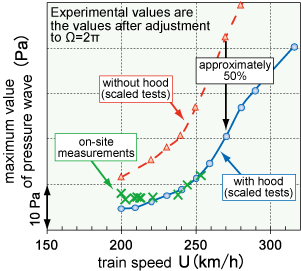1. Prediction method and countermeasures for pressure waves in short tunnel-type structures
- A numerical model was designed to predict and estimate pressure waves in short tunnel-type structures.
- Validation of a reduction in pressure with hoods.
Various types of low frequency noise are observed in the area close to tunnel portals due to passing high speed trains. “Micro pressure waves” are emblematic of this phenomenon, however, in addition to the latter, pressure waves also radiate out from the openings on both sides of short tunnel-type structures, several decametres long, such as snow shelters and overpasses, called “structure-passing waves”.
Structure-passing waves can be modeled as a superposition of four impulsive pressure waves (Fig 1). Therefore, the wave’s characteristics will vary depending on observation points creating the need to take into account the locations utilized for investigation.
Firstly, the design of the existing numerical model was improved to incorporate the effect of reducing wave amplitudes by unvented hoods, of the shifting the train center axis from the tunnel center for simulating double-track tunnel and of the barrier of tunnel portals on the pressure generated around the train nose, while also allowing fast computation predictions (Fig 2).
Secondly, scaled tests were performed to gauge the effect of reducing wave amplitudes by unvented hoods. Comparison of experimental results with actual measured values demonstrated the efficacy of the hoods (Fig 3).
The product of this work may be used as a tool when considering future wayside environmental measures.
 Fig. 1 Pressure waves generated by a train passing through a short tunnel
Fig. 1 Pressure waves generated by a train passing through a short tunnel Fig. 2 Instantaneous pressure distribution obtained by analysis when both hood
Fig. 2 Instantaneous pressure distribution obtained by analysis when both hood
lengths = 10 m and train speed = 270 km/h
Red: Positive pressure, Blue: Negative pressure Fig. 3 Efficacy of hoods
Fig. 3 Efficacy of hoods
(Comparison of scaled tests and on-site measurements)